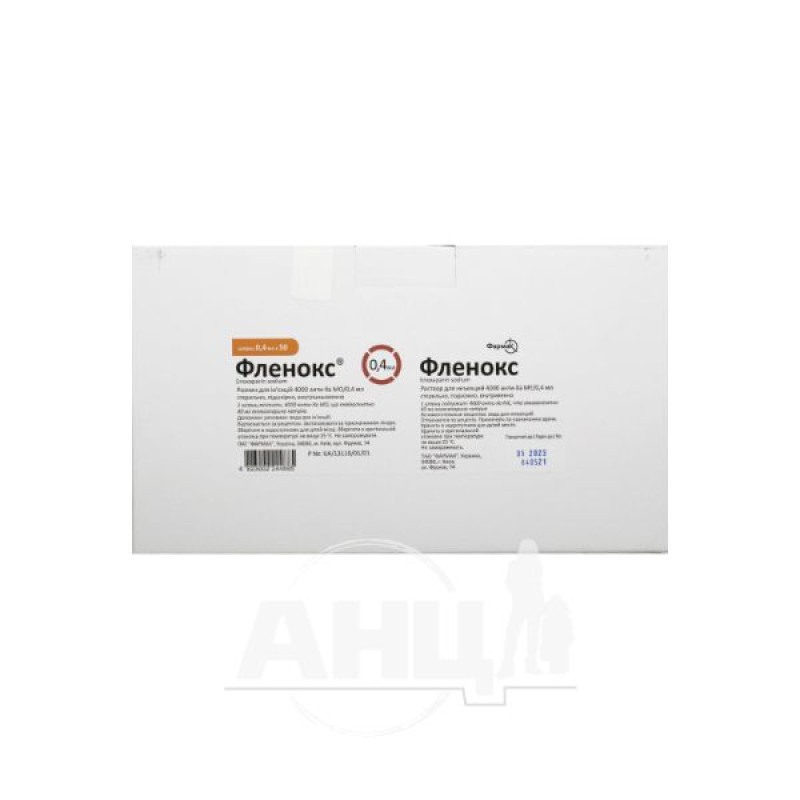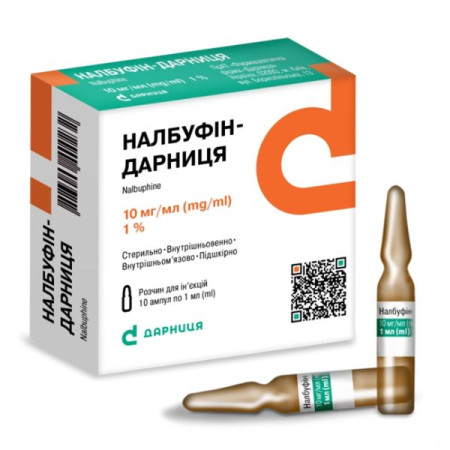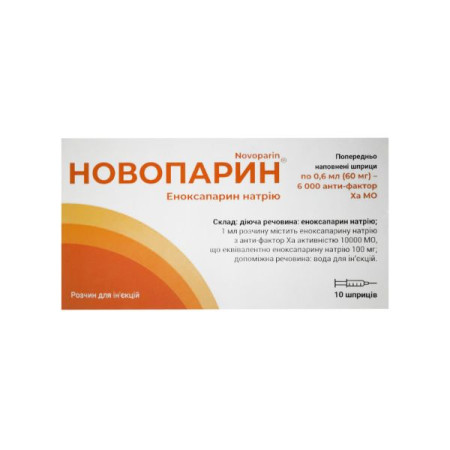Flenox injection solution 4000 IU/0.4 ml anti-Xa No. 50

Flenox injection solution is used for the following indications:
prevention of venous thromboembolism in surgical interventions accompanied by moderate and high thrombogenic risk; prevention of deep vein thrombosis in patients who are on bed rest due to acute therapeutic diseases: heart failure III or IV class according to the NYHA classification, acute respiratory failure, acute infectious or rheumatic disease, in the presence of at least one other risk factor for venous thromboembolism; prevention of thrombus formation in the extracorporeal circulation circuit during hemodialysis (the procedure lasts on average up to 4 hours); treatment of diagnosed deep vein thrombosis, which is accompanied or not accompanied by pulmonary artery thromboembolism and does not have severe clinical symptoms, with the exception of pulmonary artery thromboembolism, which requires treatment with a thrombolytic agent or surgical intervention; treatment of unstable angina and acute myocardial infarction without Q wave in combination with acetylsalicylic acid; treatment of acute myocardial infarction with ST segment elevation in combination with a thrombolytic agent in patients who may undergo further coronary angioplasty, as well as in patients who are not candidates for this procedure.Composition
Active ingredient: enoxaparin sodium;
1 ml of solution contains: 10,000 anti-Xa IU, equivalent to 100 mg of enoxaparin sodium;
4000 anti-Xa IU / 0.4 ml, equivalent to enoxaparin sodium 40 mg;
Excipients: water for injections.
Contraindication
Hypersensitivity to enoxaparin, heparin or its derivatives, including other LMWHs; history of severe heparin-induced thrombocytopenia (HIT) type II, which was caused by unfractionated heparin or low molecular weight heparin; bleeding or tendency to bleeding associated with impaired hemostasis (a possible exception to this contraindication may be disseminated intravascular coagulation, if it is not associated with heparin therapy; organic lesions that can cause bleeding; active clinically significant bleeding; the drug is usually not recommended for use in prophylactic doses in patients over 65 years of age in combination with the following drugs: acetylsalicylic acid in analgesic, antipyretic and anti-inflammatory doses; nonsteroidal anti-inflammatory drugs (NSAIDs) (systemic use); "Dextran 40" (parenteral use); intracerebral hemorrhage; active gastric or duodenal ulcer; due to the lack of relevant data, the drug is not used in patients with severe renal failure (creatinine clearance calculated by the Cockcroft formula, 30 ml / minute), with the exception of patients on dialysis; patients with severe renal failure should be prescribed unfractionated heparin (to calculate according to the Cockcroft formula, it is necessary to have data from the last measurement of the patient's body weight; spinal or epidural anesthesia should never be used in patients receiving LMWH (LMWH); local anesthesia is contraindicated in patients receiving heparin for treatment, not for prophylaxis, for elective surgical interventions; in acute major ischemic stroke with or without loss of consciousness (if the stroke is caused by embolism, enoxaparin cannot be used in the first 72 hours after the stroke); to date, the effectiveness of therapeutic doses of LMWH has not been determined, regardless of the cause, extent of the lesion, or severity of clinical manifestations of cerebral infarction; in acute infective endocarditis (except for some heart diseases caused by embolism); in mild or moderate renal failure (creatinine clearance 30-60 ml / minute).Method of application
1 mg (0.01 ml) of enoxaparin sodium corresponds to approximately 100 units of anti-Xa activity IU. Flenox should be administered subcutaneously for prophylactic and therapeutic use, except in the following cases: use of the drug for anticoagulation in hemodialysis practice; treatment of patients with ST-segment elevation myocardial infarction who require intravenous bolus administration.
Flenox should not be administered intramuscularly. The drug is recommended for use only in adult patients.
Technique of intravenous (bolus) administration/administration of Flenox for the treatment of acute ST-segment elevation myocardial infarction. Treatment is initiated with an intravenous bolus injection, followed immediately by a subcutaneous injection. Mixing or simultaneous administration of the drug with other drugs is not allowed. To eliminate residues of other drugs, and therefore to prevent their mixing with Flenox, the system must be flushed with a sufficient amount of 0.9% sodium chloride solution or 5% glucose solution before and after an intravenous bolus injection of Flenox. Flenox can be safely administered in 0.9% sodium chloride solution or 5% glucose solution.
Application features
Pregnant women
As a precautionary measure, enoxaparin at therapeutic doses should not normally be administered during pregnancy. Under no circumstances should spinal or epidural anaesthesia be performed in patients receiving therapeutic doses of LMWH.
Children
Due to the lack of relevant data, the use of LMWH in pediatric practice is not recommended.
Drivers
Taking the drug does not affect the ability to drive a vehicle or operate other mechanisms. However, caution should be exercised, taking into account possible adverse reactions.
Overdose
Accidental overdose with subcutaneous administration of significant doses of LMWH may lead to hemorrhagic complications. In case of bleeding, some patients can be treated with protamine sulfate, but it should be borne in mind that: the effectiveness of protamine sulfate is significantly lower than that observed in overdose of unfractionated heparin; before using protamine sulfate, due to the possibility of adverse events (in particular, anaphylactic shock), the benefit/risk ratio should be carefully weighed.
Neutralization of enoxaparin should be carried out by slow intravenous administration of protamine (sulfate or hydrochloride).
These recommendations are intended for patients with normal renal function receiving repeated doses of the drug. However, it is not possible to completely neutralize the anti-Xa activity of enoxaparin. In addition, neutralization may be temporary due to the pharmacokinetics of LMWH absorption, which may require dividing the total calculated dose of protamine into several injections (2-4) administered over 24 hours.
If LMWH enters the stomach, even in large quantities, serious complications are unlikely (no such cases have been recorded) due to the insignificant absorption of the drug in the stomach and intestines.
Side effects
In clinical trials, bleeding was the most commonly reported adverse reaction. This included serious bleeding, which was reported in 4.2% of patients (surgical). Some of these cases were fatal.
Interaction
undesirable combinations
With acetylsalicylic acid in analgesic, antipyretic and anti-inflammatory doses (and by analogy other salicylates). The risk of bleeding increases (suppression of platelet function and damage to the gastrointestinal mucosa under the influence of salicylates). Antipyretic analgesics that do not belong to salicylates should be used (e.g. paracetamol).
With NSAIDs, including ketorolac (systemic use). Increased risk of bleeding (suppression of platelet function and damage to the gastrointestinal mucosa by NSAIDs). If concomitant use cannot be avoided, careful clinical monitoring should be performed.
With dextran 40 (parenteral administration). Increased risk of bleeding (suppression of platelet function by dextran 40).
With other thrombolytics (e.g. alteplase, reteplase, streptokinase, tenecteplase, urokinase) and anticoagulants.
Storage conditions
Store in the original packaging at a temperature not exceeding 25 °C, out of the reach of children. Do not freeze.
Shelf life - 2 years.
There are no reviews for this product.
There are no reviews for this product, be the first to leave your review.
No questions about this product, be the first and ask your question.


